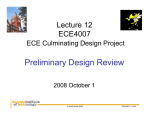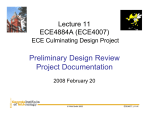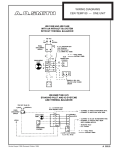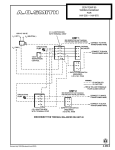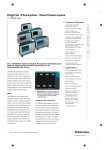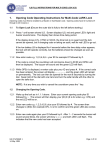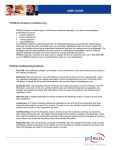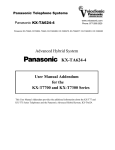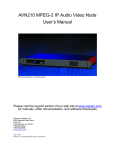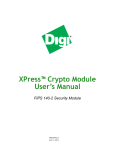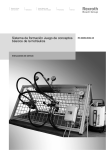Download Preliminary Design Review
Transcript
Lecture 10 ECE4007 ECE Culminating Design Project Preliminary Design Review 2009 September 23 © Whit Smith 2009 ECE4007 : L10 : P1 © Whit Smith 2009 ECE4007 : L10 : P2 © Whit Smith 2009 ECE4007 : L10 : P3 © Whit Smith 2009 ECE4007 : L10 : P4 © Whit Smith 2009 ECE4007 : L10 : P5 © Whit Smith 2009 ECE4007 : L10 : P6 © Whit Smith 2009 ECE4007 : L10 : P7 © Whit Smith 2009 ECE4007 : L10 : P8 © Whit Smith 2009 ECE4007 : L10 : P9 © Whit Smith 2009 ECE4007 : L10 : P10 © Whit Smith 2009 ECE4007 : L10 : P11 What is due by midnight? Tonight Each group’s Weekly Report Each group’s web site with TRPs & Proposal © Whit Smith 2009 ECE4007 : L10 : P12 Fall Break October 3-6 You are welcome to work on your projects © Whit Smith 2009 ECE4007 : L10 : P13 Preliminary Design Review (PDR) Finish by October 23 Details specific to your Project Advisor and section Graded jointly by your Project Advisor and UPCP Some projects (e.g. externally sponsored) may present in different venues © Whit Smith 2009 ECE4007 : L10 : P14 Preliminary Design Review (PDR) © Whit Smith 2009 ECE4007 : L10 : P15 Preliminary Design Review (PDR) Common Industrial Practice • Primary purpose is a thorough technical review – Convince whomever is funding your project that: • The design is sound • You are making reasonable progress • A favorable outcome is likely – Review specifications, particularly any changes – Give an in-depth review of the design approach and details – Review plan for demonstration and acceptance testing • Other purposes: – Review project tasks and schedule – Present marketing and cost analysis if appropriate • • • • The PDR convinces your funding source to keep on supporting you An unsuccessful PDR outcome is project cancellation Should be optimistic but realistic Don’t cover up problems! © Whit Smith 2009 ECE4007 : L10 : P16 PDR Presentation Guidelines • Presentation must be in PowerPoint (not a PDF) • Every team member must give a non-trivial part of the presentation (several minutes) • Your audience for the presentation is company management (including technical management) and engineering peers who will be evaluating your progress • You need to convince management that your project is worthy of continued support and that any problems are understood and under control • Your presentation should include graphical information such as block diagrams, screen layouts, flow charts, etc. and not just text • Should clearly indicate current project status © Whit Smith 2009 ECE4007 : L10 : P17 Preliminary Design Review (PDR) Christina Bourgeois will be visiting our lecture to discuss presentation issues. © Whit Smith 2009 ECE4007 : L10 : P18 General to Specific •You cannot show your entire project at a fully detailed level of abstraction. •You are the ones who select what specifics to show. •Choose what is relevant to the point you are illustrating, & your audience. •You are demonstrating your creativity. © Whit Smith 2009 ECE4007 : L10 : P19 Presentation Styles MTV Versus 1950’s TV News Broadcast © Whit Smith 2009 ECE4007 : L10 : P20 Presentation Styles Quick cutting between images, often with handheld cameras, is typical fare for your generation. (e.g. the contemporary Bourne movies) This is maddening to many older folks. The older folks are probably paying you. © Whit Smith 2009 ECE4007 : L10 : P21 Post Group Photos with Names Name the file groupphoto.jpg and place it in your home page directory within a week of your PDR presentation. © Whit Smith 2009 ECE4007 : L10 : P22 Practice Practice Prevents •exceeding your time limit •temptation to read from the screen •anxiety, embarrassment, & shame © Whit Smith 2009 ECE4007 : L10 : P23 Q&A Repeat the questioner’s question. The best responses sound like enthusiastic replies to a respected peer. Authenticity is a winner. Do not start waffling, babbling, crying… Do not lie. Just, don’t. The result is a total loss of credibility. If you do not know, it is acceptable to say effectively: “…I do not know but shall find out and get back to you…” Brent’s Q&A 1:05/1:22 © Whit Smith 2009 ECE4007 : L10 : P24 Project Documentation for the PDR • A PDR presentation cannot properly show all needed project documentation • A supplementary documentation package may be required (check with your project advisor) • Should convey technical details beyond the scope of a presentation such as: – – – – Detailed schematics Mechanical drawings Screen layouts (GUI details) Detailed block diagrams and flow charts • Ask your Advisor: Is a hardcopy package required at presentation time? © Whit Smith 2009 ECE4007 : L10 : P25 Project Documentation A critical aspect of your final project deliverables (& supporting your PDR for some Project Advisors). © Whit Smith 2009 ECE4007 : L10 : P26 Types of Project Documentation • System (High) Level – “Big picture” block diagrams • Detail (Low) Level – Electrical schematics, mechanical drawings • Interconnections – How different modules are connected • Software – Flow charts, commented source code • End User (Customer) Documentation – Operator’s manual, maintenance manual, etc. • General Project – Document the design process © Whit Smith 2009 ECE4007 : L10 : P27 High Level Block Diagrams Needed for every report and presentation © Whit Smith 2009 ECE4007 : L10 : P28 Previous Example – System Description • PC-Based Oscilloscope (TDS5034) – Controls multiplexer via USB interface – Controls pulser-receiver via GPIB interface – Runs LabView • Pulser Receiver – Signal output goes to scope input and is digitized – Transmit and Receiver are connected to the Mux • Eight Channel Multiplexer – Supports up to 8 transducers – Routes Transmit and Receive to/from transducers – USB interface with scope PC © Whit Smith 2009 ECE4007 : L10 : P29 Previous Example – System Block Diagram 5800PR Pulser/Receiver GPIB (Control) Signal Out (analog - coax) TDS5034 (LabView) Transmit (analog - coax) Digitized by TDS5034 USB (Control) USB Converter (inside Mux) Digital Control (Ribbon Cable) • Much clearer • More information Receive (analog - coax) Multiplexer To/From Transducers © Whit Smith 2009 ECE4007 : L10 : P30 Would you rather: Look at a Block Diagram or Read a Text Description? © Whit Smith 2009 ECE4007 : L10 : P31 High Level Block Diagrams Needed for every report and presentation • Show functional elements – these are not necessarily physical elements, although they often are • Clearly label each element • Indicate interconnections and connectivity type (e.g. analog, digital, data bus, etc.) • Label all interconnections • Use arrows to show directionality © Whit Smith 2009 ECE4007 : L10 : P32 Example – System Description Ultrasonic Structural Health Monitoring System • Sensor Cluster – – – – Multiple ultrasonic sensors (up to 16 per cluster) Each sensor can operate as a transmitter or a receiver Synchronization between all sensors in a cluster Processing capabilities for local data analysis • Structure with Multiple Sensor Clusters – Local sensors for monitoring small areas – Global sensors for monitoring large areas • Wireless Link – Sends raw waveforms or processed data to base station – COTS USB link (2.4 GHz) • Base Station – Further processing of data – Can link/combine data from multiple sensor clusters © Whit Smith 2009 ECE4007 : L10 : P33 Example – System Description Ultrasonic Structural Health Monitoring System Wireless USB Link Local Sensor Cluster #1 Local Sensor Cluster #2 Waveform and/or Feature Data Local Processing Local Central Processing Station Global Structural Component © Whit Smith 2009 ECE4007 : L10 : P34 Temperature Monitor Display Temperature Sensor A/D Converter Interface Logic Microprocessor Keypad Functional Block Diagram © Whit Smith 2009 ECE4007 : L10 : P35 Electronic Files • Mechanical drawings • Electrical/electronic schematics • Software source code • Project planning charts Use a version/revision scheme for naming files, and on all title blocks and software headers. Date and keep a chronological record of revisions. © Whit Smith 2009 ECE4007 : L10 : P36 Typical ANSI Standard Title Block ANSI = American National Standards Institute List of revisions Revision letter Title Drawing number File information © Whit Smith 2009 ECE4007 : L10 : P37 Electrical/Electronic Schematics • Physical layout: – Show components, I/O connectors, and interconnections between circuit blocks • Parts list: – List all procured parts and vendors – Numbers assigned must agree with physical layout and schematics • Schematics: – Label components with part numbers, values, and identifier numbers (e.g. U1, U2, R1, R2, …) – Label all I/O connectors and interconnections between schematics – Try to make signals “flow” from left-to-right and top-tobottom (inputs on left/top, outputs on right/bottom) © Whit Smith 2009 ECE4007 : L10 : P38 Schematic Example VHF Pre-Amplifier: Ramsey PR-20 Units: Capacitors Resistors Signal Flow Power Flow Inductor Arrow © Whit Smith 2009 ECE4007 : L10 : P39 Complex Schematic Example • Servo controller board – Multi-page schematic – Component overlay – Silkscreen overlay © Whit Smith 2009 ECE4007 : L10 : P40 Data Bus Pins of connector J2 All components have a unique ID Signals going to other pages © Whit Smith 2009 Company Logo Company Name ECE4007 : L10 : P41 © Whit Smith 2009 Nameand • Company Signals flowCompany left-to-right top-to-bottom (usually) Logo • Connectors: left & right • Signals going to and coming from other pages:ECE4007 top &: L10 bottom : P42 Show power and ground on connectors Company Logo © Whit Smith 2009 Company Name ECE4007 : L10 : P43 Unused Gates Company Logo Voltage regulator and decoupling caps © Whit Smith 2009 Company Name ECE4007 : L10 : P44 • Physical locations shown for all parts • All part numbers identified • All component values identified © Whit Smith 2009 ECE4007 : L10 : P45 • Physical locations related to unique component identifiers • Part numbers and component values are often on this drawing (better than separate drawings) © Whit Smith 2009 ECE4007 : L10 : P46 Mechanical Assembly Drawing © Whit Smith 2009 ECE4007 : L10 : P47 Company logo and address Mechanical Assembly Drawing © Whit Smith 2009 ECE4007 : L10 : P48 Mechanical Assembly Drawing © Whit Smith 2009 ECE4007 : L10 : P49 Mechanical Assembly Drawing © Whit Smith 2009 ECE4007 : L10 : P50 Typical Part Number Block Points to Associated Mechanical Detail Drawing © Whit Smith 2009 ECE4007 : L10 : P51 Mechanical Detail Drawing (from Assembly Drawing) © Whit Smith 2009 ECE4007 : L10 : P52 Mechanical Detail Drawing (from Assembly Drawing) © Whit Smith 2009 ECE4007 : L10 : P53 Interconnection Documentation • Interconnections can be internal (e.g., between boards in a chassis) and external (e.g., between instruments in a system) • No standard way to document interconnections • Standard cables can be identified by part number and name (e.g., CAT6, USB) • Custom cables have to be described in detail – Drawing showing construction details, and/or – Table showing pin numbers and wire colors (if needed) • Wiring (connections with discrete wires) has to be described in detail © Whit Smith 2009 ECE4007 : L10 : P54 System Block Diagram Calls Out Interconnections 5800PR Pulser/Receiver GPIB (Control) Signal Out (analog -coax) TDS5034 (LabView) Transmit (analog - coax) Digitized by TDS5034 USB (Control) USB Converter (inside Mux) Digital Control (Ribbon Cable) Receive (analog - coax) Multiplexer Custom cable – needs further documentation To/From Transducers © Whit Smith 2009 ECE4007 : L10 : P55 Example – DB9 to Ribbon Cable 1 2 3 4 5 1 10 DB9 Header 2 9 3 8 4 7 5 6 Ribbon Header 6 7 8 9 DB9 Pin Description Ribbon Pin 1 Ground 1 2 +5V 2 3 Data0 3 4 Data1 4 5 Data2 5 6 Data3 9 7 Code0 8 8 Code1 7 9 Ground 6 Not Used 10 Different manufacturers can number pins differently! © Whit Smith 2009 ECE4007 : L10 : P56 Software Documentation • Usually a flowchart is useful for helping someone else understand the “flow” • Also helps the designer figure out how various modules of the software interact • Software documentation should enable someone else to work on your code • Well-written and commented source code is absolutely essential © Whit Smith 2009 ECE4007 : L10 : P57 Example “High Level” Flow Chart Parameters for each channel are transmitter, receiver, P/R setup file, and TDS5034 setup file Start Define channel sequence and parameters No Ready to acquire? Yes Acquire/store single measurement from all channels No Done? Yes © Whit Smith 2009 Initiated either by keystroke or timed Stop ECE4007 : L10 : P58 Code Examples • Are revisions identified and described ? • Is formatting consistent and clear ? • Are comments are appropriate (not too few or too many) ? • Are variable names reasonable (descriptive without being too long) ? © Whit Smith 2009 ECE4007 : L10 : P59 Maintain Version and Revision Control of Software Use a version control software product such as: Microsoft Visual SourceSafe Subversion © Whit Smith 2009 ECE4007 : L10 : P60 Typical Software Version Control Features • Automatically tracks and controls source code changes. • Provides sharing and linking capabilities for multiple developers. • Supports parallel development and branching. • There are overhead costs associated with using version control software. © Whit Smith 2009 ECE4007 : L10 : P61 General Revision/Version Control • Most companies follow strict procedures for version and/or revision control after the product is completed. • Normally required to comply with dictates of most quality assurance systems. • ECN (Engineering Change Notice) Unique Numbers • DCN (Design Change Notice) • Keep an index of ECN/DCN numbers © Whit Smith 2009 ECE4007 : L10 : P62 Customer Documentation • User’s (Operator’s) Manual – How does the end user interact with the product? – Engineers usually have to write at least some, and often most, of the User’s Manual (particularly software engineers) • Maintenance Manual – What does the end user (or the manufacturer) need to know to maintain the product? – Engineers usually write this manual • Many technical writing opportunities for design engineers © Whit Smith 2009 ECE4007 : L10 : P63 Documenting the Design Process • Laboratory notebooks (or some paper system of recording your design progress) – “Work in progress” sketches, schematics, flow charts, block diagrams, etc. • Electronic files – Software source code – Drawings and schematics • Project correspondence – Emails, notes from phone calls, letters, etc. • Other project documentation © Whit Smith 2009 ECE4007 : L10 : P64 Project Correspondence • Any information transmitted to and/or shared with others that relate to the project. • Customer letters and emails • Internal memos and emails • Keep a posted hard copy file with a file index (Table of Contents) to document important project correspondence • Important to keep organized and up-to-date © Whit Smith 2009 ECE4007 : L10 : P65 Misc. Project Documentation • Related research articles • Vendor information • Purchasing records • Meeting notes • Copies of electronic files © Whit Smith 2009 ECE4007 : L10 : P66 Lecture 10 ECE4007 ECE Culminating Design Project Preliminary Design Review 2009 September 23 © Whit Smith 2009 ECE4007 : L10 : P67



































































